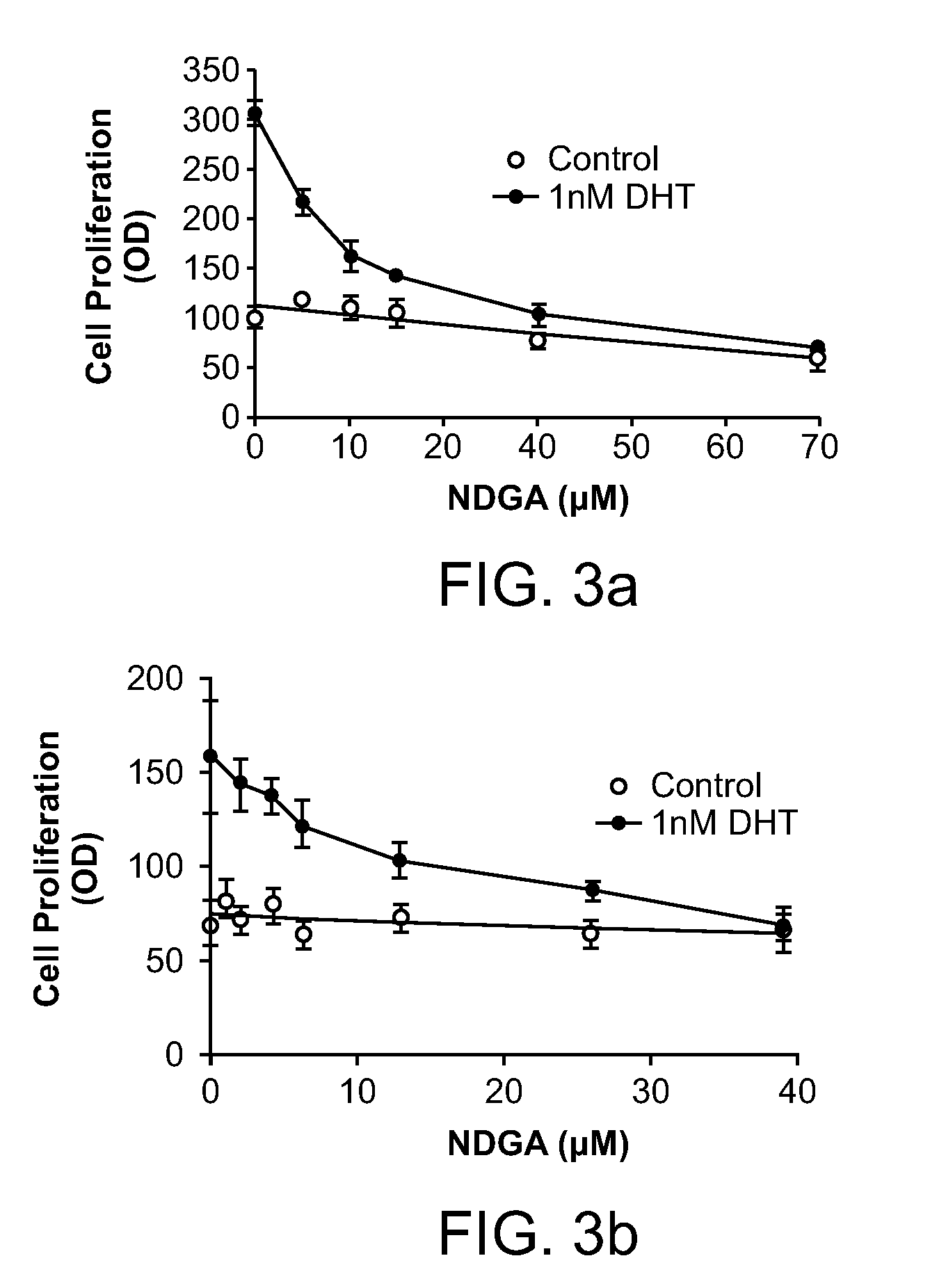Inhibitory effects of nordihydroguaiaretic acid (NDGA) on the igf-1 receptor and androgen dependent growth of lapc-4 prostate cancer cells
a technology of nordihydroguaiaretic acid and igf-1 receptor, which is applied in the field of cancer treatment, can solve the problems of loss of potency, serious side effects, and unknown contribution of each pathway towards the development of human prostate cancer, and achieve the effect of increasing the expression of igf-1 receptor
- Summary
- Abstract
- Description
- Claims
- Application Information
AI Technical Summary
Benefits of technology
Problems solved by technology
Method used
Image
Examples
example 1
Growth Studies of LAPC-4 Prostate Cancer Cells
[0104]LAPC-4 prostate cancer cells were maintained at 37° C., 5% CO2 in phenol-free RPMI+10% FCS RPMI. Steroid free medium consisted of phenol-free RPMI supplemented with 10% dextran-coated, charcoal-treated serum (10% CDSS RPMI). LAPC-4 cells were incubated in this steroid-free 10% CDSS RPMI for 3 days prior to plating in 96 well plates (5×103 cells / well). Cells were allowed to adhere overnight and were then treated with androgens and various concentrations of NDGA with DMSO as a vehicle control. The medium with androgens and inhibitors was refreshed on day 3. The plates were harvested on day 7 by inverting the microplate onto paper towels with gentle blotting to remove growth medium without disrupting adherent cells and freezing them at −80° C. for at least 30 minutes. LAPC-4 prostate cancer cell growth was determined using either the CyQuant cell proliferation assay (Molecular Probes, Eugene, Oreg.) or by the BCA assay (Pierce, Rockfo...
example 2
Effect of IGF-1 Receptor Inhibitors on DHT-Induced Prostate Cancer Cell Growth
[0107]To understand the role of the IGF-1 receptor on the DHT-induced increase in growth, we studied molecules that inhibit this receptor by unrelated mechanisms of action: NVP-AEW541 and picrodopophyllin (PPP). See Garcia-Echeverria et al. (2004) and Gimita et al. (2004). The former blocks ATP binding to the receptor, and the latter blocks substrate phosphorylation. Both agents completely blocked the effect of 1 nM DHT to stimulate proliferation with much smaller effects on non-androgen mediated growth. See FIG. 2; each value is the mean+SD for triplicate determinations. NVP-AEW541 was effective between 1 and 10 μm (FIG. 2a), and PPP was effective between 100 and 400 nM (FIG. 2b). These data support the hypothesis, therefore, that DHT and the IGF-1 receptor may have cooperative functions in stimulating cell growth, and that blocking the function or activity of IGF-1 receptor completely blocks any prostate...
example 3
NDGA Inhibitis DHT-Induced Prostate Cancer Cell Growth
[0108]LAPC-4 cells were androgen starved, as described above, for 3 days. Cells were plated in 96-well plates in 0.2% agar layer over 0.4% base agar layer as follows: To prepare 0.4% base agar layer, 0.8% agar solution at 37° C. was mixed with 2×10% CDSS RPMI. Cells were harvested and resuspended in culture medium (10% CDSS RPMI). For each well to be plated, 20 μl of 0.8% agar was mixed with 40 μl cells and 20 μl 2×10% CDSS RPMI. When the top layer solidified, 1 nM dihydrotestosterone (DHT) was added in 50 μl of 1×5% CDSS RPMI. NDGA was applied in 50 μl of 1× media the following day. Cells were refreshed on day 3. Cells were grown for 6 days at 37° C., 5% CO2. Experiments were terminated on day 6, by aspirating the liquid culture and solubilized in 3 M guanidine isothiocyanate at 45° C. for 1 hour. The CyQuant cell proliferation assay was then employed.
[0109]The effect of NDGA on DHT-induced cell proliferation was first evaluated...
PUM
| Property | Measurement | Unit |
|---|---|---|
| time | aaaaa | aaaaa |
| pH | aaaaa | aaaaa |
| temperature | aaaaa | aaaaa |
Abstract
Description
Claims
Application Information
 Login to View More
Login to View More - R&D
- Intellectual Property
- Life Sciences
- Materials
- Tech Scout
- Unparalleled Data Quality
- Higher Quality Content
- 60% Fewer Hallucinations
Browse by: Latest US Patents, China's latest patents, Technical Efficacy Thesaurus, Application Domain, Technology Topic, Popular Technical Reports.
© 2025 PatSnap. All rights reserved.Legal|Privacy policy|Modern Slavery Act Transparency Statement|Sitemap|About US| Contact US: help@patsnap.com



